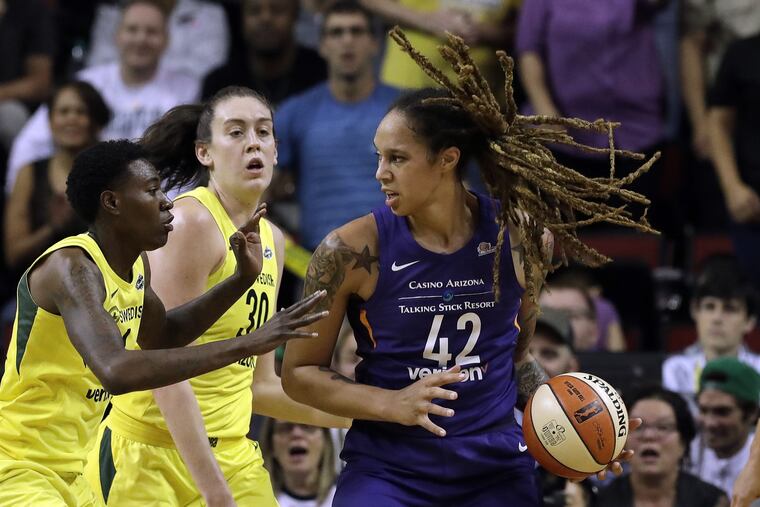WNBA players want to be paid more, but can the league accommodate them?
This issue of salaries is a concern that could lead to a labor conflict after the 2019 season.

WASHINGTON – Just about everyone who takes up the conversation about salaries in the WNBA agrees on two things.
First, based on their skill level and work ethic, WNBA players deserve to get more money.
Second, no player in the WNBA will ever get LeBron James, Stephen Curry or even Joel Embiid money.
Contrary to popular belief, WNBA players understand that their league does not generate the revenue necessary for them to get paid on par with their NBA counterparts. The issue is finding the happy, fair and reasonable number in between.
It's a concern serious enough that it might cause the WNBA Players Association to opt out of the current collective bargaining agreement, which won't expire until 2022, after the 2019 season.
If that happens, it will be the most serious concern the 22-year-old league has faced.
"To me, this conversation has been going on for a very long time," said Tina Charles, a New York Liberty forward and six-time WNBA All-Star, who just completed her eighth season. "It's not until [the players] take some kind of action that anything is going to change.
"With our CBA coming up, I look forward to seeing what kind of action we will take. I'm not sure how drastic, but everyone is at the point where we feel something needs to happen, and that's only going to come if we take action."
Established and opened for business in 1996, the WNBA has seen the culture and climate of women's sports evolve exponentially over the past two decades, but the league itself has grown only marginally as a business entity during that time.
It was owned as a single entity by the NBA and subsidized by the billions of dollars the men's league made. Originally, the NBA owned all the franchises.
Led by then-commissioner David Stern, the Association viewed the WNBA as a long-term business investment, banking that it would grow eventually into a profitable revenue stream. It didn't, or at least not to the expectations of the NBA. In 2002, it sold teams to either their NBA counterparts or third parties.
That meant the league's salary structure was no longer set by the NBA. It was controlled by the most basic economic principle: the law of supply and demand.
"Whatever sport, job you are in, entertainer, you make what the market bears," said veteran Washington Mystics coach Mike Thibault, whose team was swept by the Seattle Storm in the best-of-five WNBA Finals on Wednesday. The players, he added, "are making what the market bears right now, unfortunately.
"But until we start having bigger crowds, more revenue, the reality is that not many teams are actually making money."
That doesn't pacify the players.
This is a new generation of women's basketball player. The ones coming into the WNBA today have never really known a time when there was not a professional women's league in the United States. They don't know a time when American women had to go overseas to make any money from playing basketball.
These players weren't born when Hall of Fame legend Larry Bird set a rookie contract record by signing a five-year deal worth $3.25 million — or $650,000 a year — in 1979. It took 33 seasons for the NBA to get that point – 11 more than the WNBA has existed.
When Magic Johnson signed a 25-year extension worth $25 million in 1981, he joined Kareem Abdul-Jabbar and Moses Malone as the only NBA players making $1 million a season at that time.
The maximum salary for the 2018 season in the WNBA was $115,500. The minimum for three or more years of service was $56,100, and $41,202 for two or fewer years, with a rookie scale between $40,000 and $50,000.
The minimum salary for an NBA player for the 2018-19 season will be $838,464. The highest-paid players in the WNBA make less than 14 percent of that.
According to Forbes magazine, the NBA generated nearly $7.7 billion in revenue in 2016-17. The actual revenue generated by the WNBA is not known, but Forbes had a recent article that projected the WNBA's at a minimum of $52.4 million.
Of course, operating costs such as salaries for all employees, facility use, game-day operations, marketing, travel, housing, player per diems, health insurance, a 401(k) plan and other business expenses have to be subtracted from the revenue.
How much does that leave for increased pay?
From the WNBA players' perspective, it doesn't really matter. They just see that they still have to play in foreign countries after the season to supplement their WNBA wages.
"You can live off of [the WNBA salary]," said Mystics guard and former Saint Joseph's player Natasha Cloud, who is about to finish her rookie contract. "You have to budget, but if it's just me, yes, it's a living wage.
"But we're just like male athletes. This is how we provide for our families. We don't want to have to go overseas away from our families for seven months out of the year to make a decent amount of money."
Even though the WNBA and NBA are both basketball leagues, this is not an equal-pay-for-equal-work situation. As business organizations, they don't have much in common beyond three letters in their names.
The reality of what the WNBA is as a business compared with the NBA is does not necessarily factor into the players' thoughts. They're simply looking for higher salaries.
"What's the meeting area?" said WNBA rookie of the Year A'ja Wilson, a member of the Las Vegas Aces. "That's what we're trying to figure out.
"We're not out here demanding that we make equal as the men. We're just saying we should be paid what we are worth. We're not saying it's a gazillion dollars, but it's more than what we get right now."